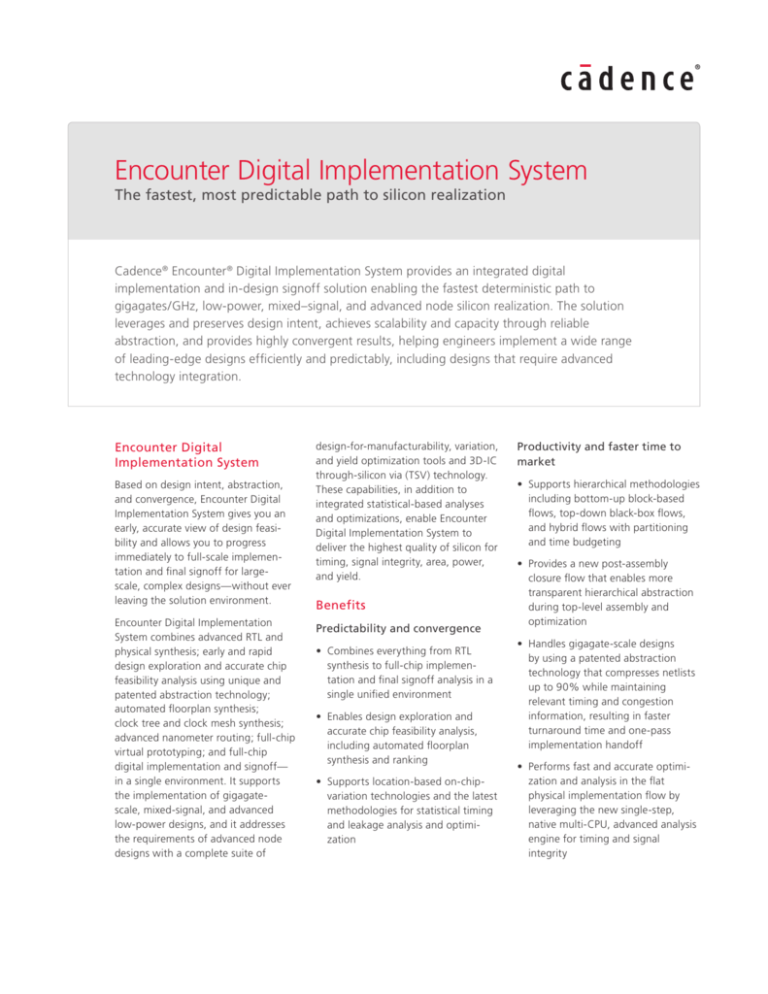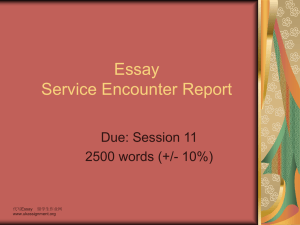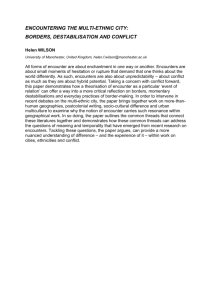
Encounter Digital Implementation System
The fastest, most predictable path to silicon realization
Cadence® Encounter® Digital Implementation System provides an integrated digital
implementation and in-design signoff solution enabling the fastest deterministic path to
gigagates/GHz, low-power, mixed–signal, and advanced node silicon realization. The solution
leverages and preserves design intent, achieves scalability and capacity through reliable
abstraction, and provides highly convergent results, helping engineers implement a wide range
of leading-edge designs efficiently and predictably, including designs that require advanced
technology integration.
Encounter Digital
Implementation System
Based on design intent, abstraction,
and convergence, Encounter Digital
Implementation System gives you an
early, accurate view of design feasibility and allows you to progress
immediately to full-scale implementation and final signoff for largescale, complex designs—without ever
leaving the solution environment.
Encounter Digital Implementation
System combines advanced RTL and
physical synthesis; early and rapid
design exploration and accurate chip
feasibility analysis using unique and
patented abstraction technology;
automated floorplan synthesis;
clock tree and clock mesh synthesis;
advanced nanometer routing; full-chip
virtual prototyping; and full-chip
digital implementation and signoff—
in a single environment. It supports
the implementation of gigagatescale, mixed-signal, and advanced
low-power designs, and it addresses
the requirements of advanced node
designs with a complete suite of
design-for-manufacturability, variation,
and yield optimization tools and 3D-IC
through-silicon via (TSV) technology.
These capabilities, in addition to
integrated statistical-based analyses
and optimizations, enable Encounter
Digital Implementation System to
deliver the highest quality of silicon for
timing, signal integrity, area, power,
and yield.
Benefits
Predictability and convergence
• Combines everything from RTL
synthesis to full-chip implementation and final signoff analysis in a
single unified environment
• Enables design exploration and
accurate chip feasibility analysis,
including automated floorplan
synthesis and ranking
• Supports location-based on-chipvariation technologies and the latest
methodologies for statistical timing
and leakage analysis and optimization
Productivity and faster time to
market
• Supports hierarchical methodologies
including bottom-up block-based
flows, top-down black-box flows,
and hybrid flows with partitioning
and time budgeting
• Provides a new post-assembly
closure flow that enables more
transparent hierarchical abstraction
during top-level assembly and
optimization
• Handles gigagate-scale designs
by using a patented abstraction
technology that compresses netlists
up to 90% while maintaining
relevant timing and congestion
information, resulting in faster
turnaround time and one-pass
implementation handoff
• Performs fast and accurate optimization and analysis in the flat
physical implementation flow by
leveraging the new single-step,
native multi-CPU, advanced analysis
engine for timing and signal
integrity
• Enables concurrent chip/package
design and optimization with integrated
capabilities such as automatic area and
peripheral I/O placement and flip-chip
RDL routing
• Allows floorplanning, implementation,
and analysis of 3D stacked-die designs
for optimization of heterogeneous
processes/dies
• Ensures fewer iterations and faster
convergence with in-design 3D-IC
signoff extraction and timing, power,
and thermal analysis across multiple
dies
Gigagates/GHz Design
Encounter Digital Implementation System
supports all implementation styles for flat
or hierarchical designs. Capabilities such
as fast power-grid design and optimization, global routing, in-place optimization, and global timing/power/clock
debug provide a robust infrastructure to
implement any methodology.
Early design exploration
Today’s physical design teams start
physical implementation and design
planning very early in the design cycle—
with early and multiple versions of the
design netlist—to determine design feasibility. Encounter Digital Implementation
www.cadence.com
ce
an
iv i
Sig
m
Are
a
eter Routin
g
nom
Na
ct
ty
Per
f
or
n o ff A n a l y s i
l Synthe
ysica
sis
Ph
• Supports comprehensive multi-mode/
multi-corner analysis and optimization
in all steps across the design flow
du
Differentiated product development
with lower production costs
Design
Closure
P ro
• Offers a complete, end-to-end,
multi-core parallel processing
backplane and infrastructure
oS
/Q
Pred
ic
ity
bil
ta
• Delivers industry-leading performance
and capacity for large, complex chips
g
Pl
Design Closure
Low-Power Design
Advanced Node Design
Signoff Analysis
Scalability in performance
lI
Digita mpleme
er
t
nt
n
a
/Prototyp
ou
ning
i
n
n
a
n
tio
• Delivers signoff-driven implementation
and intuitive, visual features for global
timing, power, and clock debug and
diagnostics
En
c
Encounter Digital Implementation System
Mixed-Signal Design
DFM
s
Stacked Die
Figure 1: Encounter Digital Implementation System delivers a comprehensive solution
System closes the gap between architecture and implementation, addressing
questions such as whether the design can
be implemented in the required area, and
if it will operate at the desired speed.
• Patented abstraction models provide
necessary netlist compression with
the accuracy and fast turnaround
time needed to handle gigagate-scale
designs
• Production-proven automated floorplan
synthesis (Cadence First Encounter ®
technology) couples timing, power,
area, and congestion-aware placement
with fast global routing and in-place
optimization; you can quickly generate
prototype floorplans
• System designers can link into
Encounter Digital Implementation
System from Cadence Chip Planning
System to bring physical predictability
into their estimations
• A new automatic macro placement
capability generates macro placement
results that are convergent with
implementation
• Built-in editing capabilities such
as relative floorplan (specifying
relationships for pre-routes, resizable
objects, multiple relations, datapath
stacking, integrated analysis tools)
and resize floorplan help you quickly
and accurately reach an optimal final
floorplan
• A floorplan ranking system automatically generates multiple floorplan
scenarios in parallel and analyzes them
based on pre-defined quality-of-results
criteria; you can explore as much of the
physical solution space as possible and
make the most informed tradeoffs
Silicon virtual prototyping and
hierarchical support
Full-chip flat prototyping delivers
complete physical, timing, clock, and
power data, eliminating the guesswork
associated with traditional block-based
approaches. Hierarchical support helps
physical designers assess how best to
partition the logical hierarchy into physical
modules. You can analyze the optimal
pin assignments, budget time quickly,
accurately predict the clock distribution
networks, analyze the power grids, and
eventually generate complete timing
and physical constraints for each of the
physical modules. In addition, the new
post-assembly closure flow enables more
transparent hierarchical abstraction at the
top level, where blocks can be optimized
concurrently for faster, more predictable
hierarchical design closure.
2
Encounter Digital Implementation System
Advanced timing closure
Encounter Digital Implementation
System’s global physical synthesis
capability optimizes multiple paths while
also performing multi-dimensional and
concurrent optimization for timing, signal
integrity (SI), power, area, congestion,
wire length, and yield using native signoff
engines. You can also achieve significant
improvements in performance, accuracy,
and throughput using robust, end-toend multi-mode/multi-corner analysis
and optimization technologies. Encounter
Digital Implementation System allows you
to perform advanced timing optimization
for timing-critical designs with a single
command.
With its patented architecture, SMART2
routing technology (concurrent SI,
manufacturing-aware, routability, and
timing optimization), litho-aware routing,
and the industry’s only superthreading
technology, Cadence NanoRoute ®
Advanced Digital Router is unmatched
in quality and performance for blocklevel and top-level routing. It addresses
multiple design objectives concurrently
for the ultimate DRC-clean, tapeout-ready
GDSII database.
NanoRoute grid- and graph-based
routing and optimization technologies
also support the latest 40nm and
28/32nm design rules. It delivers a
full suite of design-for-yield features
including concurrent via-doubling and
reduction, wire spreading and widening,
variation control, and lithography hotspot
prevention and optimization. NanoRoute
superthreading technology combines
the best of multi-threading, multi-core,
and parallel-processing techniques. This
enables you to route millions of nets
per hour on both readily available, costeffective 32-bit compute technologies and
the latest multi-core processing hardware.
At the SI analysis and signoff stage,
Encounter Digital Implementation System
now leverages an advanced analysis
engine that calculates timing and SI in a
single step. This significantly speeds up
post-route SI closure and results in faster
convergence for design closure.
www.cadence.com
Advanced global debug and
diagnostics
Debug and diagnosis challenges often
come late in the design cycle, along the
critical path to final tapeout. Encounter
Digital Implementation System provides
timing, power, and clock debug and
diagnostics capabilities that allow you
to quickly locate and visualize interdependent timing, clock, and power issues,
and then quickly resolve them using
powerful “what-if” analysis techniques.
These results can be immediately implemented in physical design.
Advanced RTL synthesis
RTL synthesis for high-performance
systems requires not only high
capacity but also advanced features to
optimize the design. Encounter Digital
Implementation System supports register
re-timing, accurate physical layout
prediction, and multi-supply voltageaware synthesis to achieve high quality
of silicon. Its integrated and physicallyaware synthesis technology enables
you to dramatically improve gate-level
netlists derived from other synthesis tools,
resulting in superior timing, area, and
power.
In-design signoff analysis
Successful digital chip design hinges on
accurate and consistent signoff analysis.
By integrating with Encounter Power
System, Encounter Timing System, and
Cadence QRC Extraction, Encounter
Digital Implementation System addresses
logical, physical, electrical, and manufacturing domain requirements in a single,
easy-to-use environment. This provides
convergent front-end to back-end design
handoff, signoff-driven implementation,
and highly accurate final chip signoff
that analyzes chip timing, SI, power
consumption, statistical static timing,
electromigration, and thermal characteristics.
Such an integrated signoff solution
enables:
• Industry-endorsed and silicon-proven
timing, noise, and power analysis
during implementation and signoff
• Consistent signoff analyses and
extraction between implementation
and signoff tools for faster design
convergence
• Production-proven in-design DFM
addresses both physical and electrical
variability
• Multi-dimensional root-cause analysis
for power/timing that shaves weeks
off of tapeout schedules and prevents
silicon failures
• The fastest turnaround time for
incremental or ECO extraction
• The industry’s most precise SI analysis
for reduced crosstalk noise margins
• High-throughput, multi-core parallel
processing architecture with truly
concurrent multi-mode/multi-corner
analysis
• Early rail analysis and power-switch
optimization for a correct-byconstruction power network design
• Static and dynamic power rail analysis
including IR drop and clock-jitter impact
on timing
• Variation-aware, statistical timing and
leakage power analysis with effective
current source model support for
greater accuracy at advanced process
nodes
Low-Power and Mixed-Signal
Design
Low power
Encounter Digital Implementation
System is an integral part of the Cadence
Low-Power Solution, which provides
a complete methodology from poweraware design planning to signoff. The
underlying infrastructure of Encounter
Digital Implementation System simplifies
the implementation of low-power designs
because it is multi-power-domain–aware
across the flow. Floorplanning, placement,
clock tree synthesis, optimization, routing,
analysis, and all other steps in the design
flow comprehend and optimize power
across all domains simultaneously.
3
Encounter Digital Implementation System
Native integration of complete multisupply voltage (MSV) management
enables automatic placement of level
shifters with all power connections
completed automatically. This allows
you to implement designs that employ
advanced power reduction techniques
such as power shutoff (PSO), MSV,
dynamic voltage/frequency scaling
(DVFS), substrate biasing, and many more.
A powerful engine optimizes the power
delivery network using early rail analysis
for concurrent chip and package power
modeling, ensuring convergence for the
design’s power network.
Today’s low-power designs also have to
work seamlessly in a hierarchical flow
and leverage the abstraction advantages
available in integrating IP models from
other sources. To ensure a seamless
hierarchical flow and IP integration,
Cadence offers hierarchical low-power
macro-modeling of black boxes. This
helps you take advantage of hierarchical
abstraction as well as the scalability of
integrating IP in low-power designs.
Encounter Digital Implementation System
fully supports the Common Power Format
(CPF), which captures all power-specific
design intent, from planning to final
implementation and through to signoff.
Mixed signal
The amount of analog circuitry on SoCs
is multiplying, and at the same time,
the use of digital control logic inside
analog blocks is growing. The result is
blurred boundaries between “analog”
and “digital.” The Cadence MixedSignal Solution, utilizing OpenAccess
as a single design database, enables
analog and digital designers to retain
their own preferred design environments while increasing implementation
efficiency through easy and seamless
data transfer between Cadence Virtuoso ®
and Encounter design platforms. Both
analog and digital teams can easily see
the complete design and any changes that
might have been implemented by their
peers, enabling efficient full-chip optimizations that were previously unobtainable.
This additional interoperability has proven
extremely valuable during design stages
when both analog and digital design
www.cadence.com
teams need to carefully coordinate
and agree on potential modifications,
where simply saving the database allows
everyone on the design team to see the
latest status in their own environment.
Engineering change orders (ECOs) can be
managed more easily since they no longer
require the generation of LEF/DEF/GDSII
files to communicate the changes.
Comprehensive full-chip static timing
analysis has always been challenging for
mixed-signal designs, typically because
the custom/analog designers had to
manually create Liberty (.lib) files for their
completed mixed-signal blocks. Encounter
Digital Implementation System has a
unique ability to perform comprehensive
static timing analysis by transcending
the analog hierarchy and abstracting the
digital logic and paths.
The Cadence Mixed-Signal Solution
combines all of the strengths of Encounter
Digital Implementation System—including
design closure, signoff analysis, advanced
node design, and low-power design—
with the industry-standard Virtuoso
design platform for custom/analog
design, enabling a mixed-signal implementation solution that is second to none.
Advanced Technology
Integration
3D stacked die support
Today, vertical chip packaging schemes
are being extended to the system level.
A 3D stacked-die design environment
enables companies to design using a
heterogeneous process while achieving
even smaller silicon and package footprint
sizes and higher performance for interconnect-intensive designs. Encounter
Digital Implementation System fully
supports the design, verification, and
implementation of 3D stacked-die designs
using:
• A consistent, unified environment that
leverages 3D-IC intent (configuration
file) to drive creation, implementation,
and verification of 3D stacked-die
designs across digital, full-custom, and
packaging domains
• 3D stacked-die chip/package/test
abstraction and methodology that
provides the speed and scalability to
optimize heterogeneous processes/dies
• In-design 3D-IC signoff extraction,
timing, power, and thermal analysis
across multiple dies to ensure fewer
iterations and faster convergence
Advanced process variation support
In addition to providing foundrysupported signoff technologies for
timing, SI, and power during implementation, Encounter Digital Implementation
System employs location-based on-chip
variation (LOCV), which uses logic level
and physical location to select the optimal
de-rating factor. LOCV eliminates the
excessive guardbanding associated with
traditional de-rating and improves timing
closure.
Encounter Digital Implementation
System also supplements traditional
single- and multi-corner–based methods
with powerful and accurate statistical static timing analysis (SSTA) that
accurately accounts for variability of
process parameters in a single run. Using
effective current source models (ECSMs),
Encounter Digital Implementation System
identifies cells and nets on both clock
and data paths that are sensitive to variations, and then determines the probability
of timing failures over the full scope
of the process window. This reduces
pessimism and limits guardbanding, which
in turn reduces both area and power
consumption while improving chip performance.
Encounter Digital Implementation System
SSTA and statistical leakage analysis and
optimization capabilities further reduce
design cycles by eliminating the need
for multiple analysis runs. Designers can
tape out with the confidence of using
a foundry-endorsed statistical solution
to achieve and improve their timing and
power goals in silicon.
Design for yield
Encounter Digital Implementation System
optimizes yield issues all the way from
RTL to GDSII. At any point in the design
flow, you can perform yield analysis,
analyze multiple strategies that affect and
4
Encounter Digital Implementation System
improve yield, and optimize the design
immediately in the context of all other
optimization objectives (including timing,
SI, power, and area). Design-for-yield
(DFY) features include:
• Context-driven placement, which takes
layout electrical effects into account
during implementation, resulting in
better chip performance
• Wire spreading, wire widening,
double-cut via insertion, and single via
reduction and optimization
• Critical area analysis and optimization
• True lithography distortion prevention
and optimization, and CMP-aware
metal fill
• A rich set of random and systematic
visual analysis and text-based reporting
vehicles
Encounter Digital Implementation
System’s robust native DFY capabilities
allow you to quickly and accurately
predict manufacturing variability and
to make intelligent tradeoffs during
prototyping and implementation for
maximizing yield.
Design for manufacturing
Starting at the 45/40nm process node,
design for manufacturing (DFM) is a
mandatory step in the IC design flow.
Traditional methods of addressing DFM
variability issues at signoff are impractical;
they cannot handle increasing design
complexity and they have long turnaround
times. Advanced node design requires
starting with the end in mind; it requires
in-design DFM to scale diverse design
needs from blocks and IP to large SoCs.
Encounter in-design DFM focuses on
maintaining designer intent and leveraging accurate abstraction of manufacturing issues to deliver fast silicon
convergence for DFM variability hotspots.
Production-proven, silicon-accurate
signoff DFM technologies are integrated
with Encounter Digital Implementation
System to minimize the risk of yieldlimiting DFM hotspots and reduce the
electrical variability impact early in the
digital implementation flow.
Encounter Digital Implementation System
users can leverage Encounter DFM’s
advanced analysis capability, in which
silicon failures or variability hotspots are
abstracted into patterns while maintaining
the original design intent. This accurate
abstraction reduces the turnaround time
for DFM check analysis during digital
implementation with Encounter Digital
Implementation System by 100x, saving
several days of DFM error iteration cycle
time from the signoff stage.
Concurrent chip/package design:
flip-chip support
Proven through multiple customer
tapeouts, Encounter Digital
Implementation System’s flip-chip floorplanning and implementation technologies enable the concurrent design of
chip and package by including package
constraints and parasitic effects while
designing the IC. With support for
multiple I/O methodologies, concurrent
optimization of area and peripheral
I/Os with core instances, automatic
RDL routing with 45-degree support,
and accounting for RDL layers during
signal/power routing, Encounter Digital
Implementation System eliminates the
traditional manual steps in I/O placement
and optimization.
Platforms
• lnx86: Linux (x86 and x86_64)
32/64-bit
• sol86: Solaris (x86_64) 64-bit
• sun4v: Solaris (ultraSparc) 64-bit
• ibmrs: AIX (power) 64-bit
Cadence Services and Support
• Cadence application engineers can
answer your technical questions by
telephone, email, or Internet—they can
also provide technical assistance and
custom training
• Cadence certified instructors teach
more than 70 courses and bring
their real-world experience into the
classroom
• More than 25 Internet Learning
Series (iLS) online courses allow you
the flexibility of training at your own
computer via the Internet
• Cadence Online Support gives you 24x7
online access to a knowledgebase of
the latest solutions, technical documentation, software downloads, and more
Cadence is transforming the global electronics industry through a vision called EDA360.
With an application-driven approach to design, our software, hardware, IP, and services help
customers realize silicon, SoCs, and complete systems efficiently and profitably. www.cadence.com
© 2011 Cadence Design Systems, Inc. All rights reserved. Cadence, the Cadence logo, Encounter, First Encounter, NanoRoute, and Virtuoso are
registered trademarks of Cadence Design Systems, Inc. All others are properties of their respective holders.
21859 09/11 MK/DM/PDF








